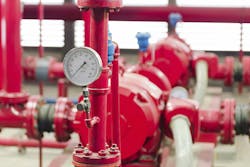Measuring the flow through water distribution systems is important due to the large economic value of the large quantities of water that are transported between locations. In many applications, these measurements are used to monitor flows, but on occasion, they are used for custody transfer and billing purposes.
Water is typically distributed in large pipes that range from approximately 12 to 120 inches in size depending on the location. Full-bore flow meters are often installed where accuracy is important, even though more economical insertion flow meters can provide reasonable accuracy when properly applied and installed.
Insertion flow meters measure flow at one location in the pipe and infer the total flow, making it subject to additional errors caused by improper sensor location and velocity profile effects. However, they are an economical alternative to full-bore flow meters when flow monitoring, especially for temporary flow measurements required to analyze operational and distribution problems.
Some time ago, I was asked to analyze the operation of a relatively large water distribution system with full-bore flow meters where closure of the water balance approximately doubled to nearly 5 percent. In this location, the water district was concerned that a poor water balance could result in large undetected water losses that could continue for long periods of time. This water district provides water to almost 2 million people, so the economic impact of water leaks could
be substantial.
Problems were detected that related to the large incoming water flow meter, some distribution flow meters and the operation of the majority of the downstream flow meter stations. The water balanced to well within 1 percent after the flow measurement issues were corrected. Modifying the flow metering station measurement and control strategies resulted in the system operating smoother with less
ongoing maintenance.
This work required a few on-site visits plus analysis afterward and helped provide water to a couple million people more efficiently and with confidence that leaks can be detected in a timely manner.
David W. Spitzer is a regular contributor to Flow Control magazine and a principal in Spitzer and Boyes LLC offering engineering; seminars; strategic marketing consulting; distribution consulting; and expert witness services for manufacturing and automation companies. Spitzer and Boyes is also the publisher of the Industrial Automation INSIDER. Spitzer has more than 40 years of experience and has written more than 10 books and 300 articles about flow measurement, instrumentation and process control. He may be reached at 845-623-1830 or at spitzerandboyes.com.
About the Author
David W. Spitzer
David W Spitzer’s new book Global Climate Change: A Clear Explanation and Pathway to Mitigation (Amazon.com) adds to his over 500 technical articles and 10 books on flow measurement, instrumentation, process control and variable speed drives. David offers consulting services and keynote speeches, writes/edits white papers, presents seminars, and provides expert witness services at Spitzer and Boyes LLC (spitzerandboyes.com or +1.845.623.1830).
